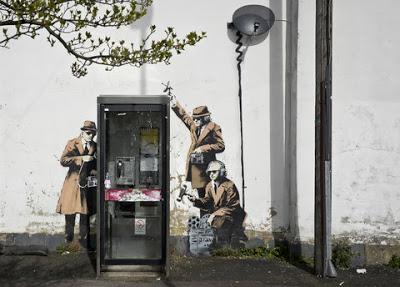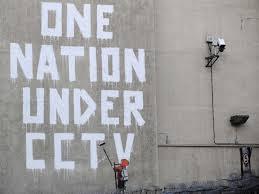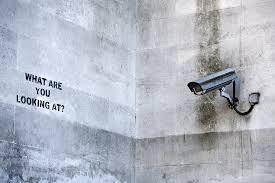
Recent geoprofiling has confirmed the identity of Banksy. But more importantly it has opened up a new method of criminalising protests under the guise of the war on terror.
Tagging Banksy
A recent paper published in the not-oft-perused Journal of Spatial Science caught the attention of the world’s press. Well, a couple of papers and one or two blogs picked up on it anyway. The paper is called “Tagging Banksy” punning, I presume, on the practice of tagging or signing your name intrinsic to street art. The paper outlines how four scientists got together and decided to use geographic profiling, normally the preserve of criminology and the study of infectious diseases, to profile the anonymous street artist who goes by the name of Bansky. There was no point to this, they admit, in that Banksy was already outed by the Daily Mail in 2008 as one Robin Gunnigham. Not letting that get in the way of a possible publication, the team set about analysing the location of nearly 200 of Bansky’s works, all of which are site-specific making him an ideal target for the geoprofiling technique.This technique consisted of mapping these works against anchor points pertinent to the life of the suspected Gunningam, such as where he lived, his school, his girlfriend’s address, his local pub and so on. Putting the data together in the same way as is used for other criminals like serial killers, it was found that in all likelihood Banksy is Paul Gunningham further suggesting that, going against the grain of most advice, he does tend to shit on his own doorstep.
One Person’s Protestor is Another’s Terrorist
In that we already knew this, and in fact it was because we knew this that Banksy was profilable in the first place, the purpose of the paper is mainly unclear until you get to the final, chilling paragraph. Here we learn that the purpose of this mode of profiling is to catch bad-guys, in particular those bad-guys that are “so hot right now”, namely terrorists. Indulging in two whole sentences of cultural history, the paper reminds us that Graffiti, acts of vandalism and the like have long been associated with protest groups. In fact, one of the first applications of protest tagging was tracing the profile, in 2014, of known anti-Nazi protestors Otto and Elise Hampel. The Hampel’s bravely left around 200 protest postcards in Berlin apartments during the war, urging their recipients to resist the Nazis.As we tend to forget, one person’s political activist is another’s terrorist and the practice of low-level protest of these kinds is something they both share in common, mainly because activists and terrorists are often the same people, described in different ways. So if one is able to trace what the authors term a terrorist’s “low level activities” not just the headline grabbing bombing and decapitating, then a new front could be opened in the war of terror, one at street level. This then is the justification for outing Banksy.
The paper ends with something of a sense of its own purposelessness and questionable ethics: “Of course, all this would be unnecessary if political protest only involved bombs stencilled on building walls”. I find myself a little confused I must confess. Are we keeping an eye on protestors in case they become something more? If so who determines when protest becomes terrorism and does this mean that all forms of social protest should be subject to invasive surveillance? Or are we trying to catch terrorists using minor acts of protest that they might also indulge in. And what of poor Robin, is he a protestor who is a terrorist in potential, or is he a terrorist suspect who also protests? Neither would appear to be the answer. We are at war; Banksy is just collateral damage.
What the paper suggests is that because of terrorism, we need to use science to improve the surveillance techniques of the modern virtual police state. What a load of nonsense. We have had terrorism for over two hundred years and we have never had at our disposal the means to track terrorists that we have now. We don’t need more tools; we need more controls on the abuse of those tools. If you doubt my argument think for a moment of the Hampels. Didn’t the Nazi’s view them as terrorists or, using the rhetoric of their age of hate, degenerates? Yes they did. It took the SS two years to trace the precise identity and location of the Hampels, but trace it they did. They were both executed in 1943.
So what precisely does geoprofiling actually facilitate? It allows a state to trace its Hampels in a couple of weeks or months, not a couple of years. And if the paper is successful and working in concert with the astonishing developments in data harvesting, face and voice recognition, digital tagging and so on, that might be reducible to a couple of hours or a couple of minutes. What this means is that the Hampels would not have enjoyed two more years of married life. What this means is maybe 100 or more postcards of protest they would have been unable to leave behind.
Weaponising Surviellance
 I appreciate that we are not living under a totalitarian regime but let me just make this point. In recent times the UK government has illegally executed several of its own citizens by drone, in particular Reyaad Khan, Rahul Amin and most famously Mohammed Emwazi. More than this, in recent years it has also sanctioned the rendition and torture of its own citizens. All in the name of an entirely bogus War on Terror. Bogus because we are not at war and so we cannot declare a state of exception and simply disregard the rule of law. And Bogus because we don’t agree what terrorism actually is in the world—and we are always in the world these days—and accordingly we don’t know who the terrorists are.
I appreciate that we are not living under a totalitarian regime but let me just make this point. In recent times the UK government has illegally executed several of its own citizens by drone, in particular Reyaad Khan, Rahul Amin and most famously Mohammed Emwazi. More than this, in recent years it has also sanctioned the rendition and torture of its own citizens. All in the name of an entirely bogus War on Terror. Bogus because we are not at war and so we cannot declare a state of exception and simply disregard the rule of law. And Bogus because we don’t agree what terrorism actually is in the world—and we are always in the world these days—and accordingly we don’t know who the terrorists are. Example, since the commencement of their bombing campaign the Russians have killed 2000 civilians in Syria, systematically, openly, with the aid of digital surveillance techniques. These techniques have been used to purposefully target civilian life in Syria, such as hospitals and schools, to demoralise the anti-Assad forces. Calling all anti-Assad protestors terrorists, the Russians have, effectively, weaponised locations of care and protection. How have they achieved this? Through the weaponising of the term Terrorist by George Bush and Tony Blair fifteen years ago allowing the Russians to use the same term to refer to anti-Assad forces. Those children, those doctors, those NGO workers who are no longer with us, are the Hampels of Syria, and geoprofiling will be a welcome tool, a welcome weapon, in the arsenal of states who wish to oppress any kind of protest, and that includes our own.
Bad Impact
For me this paper is an enemy of our freedom, and that is bad, but it is also an enemy of knowledge and I will explain why. I am an academic and so is my wife. We are embroiled on a daily basis in the politics of publication. From an outside perspective it may seem silly to publish a paper based on identifying a fact we already know, Banksy is Robin Gunningham, so why did the authors do it? Out of love for Banksy’s art? One of the authors said they thought Banksy was a cool artist but when asked if they had learnt more about his art with this paper they admitted not. No, the paper was not the product of art lovers. Rather, the choice of Banksy was a cynical ploy on the part of the authors to attain impact, a plot that has been hideously successful.Impact is a measure of how widely read a piece of work is and in scientific research all papers are assigned a numerical impact factor. This number ties into your reputation as a scientist. If you go to the Journal website where you can read the paper if you are willing to pay for it, you will even find a lovely rainbow hoop called the Altmetric. The Altmetric measures the impact of this paper in real time based on its mentions in various sources. Not just academic sources but, more importantly for the modern academic wishing to attain funding, promotion, a better life, the public impact of a piece.
Last time I looked “Tagging Banksy” has been mentioned in 60 news sources and 4 blogs, make that 5 now. It had been mentioned on Twitter over 500 times. In short, in answer to the question what does this paper prove, what does it add to knowledge, the answer is you are missing the point. Increasingly modern academia is not about adding to knowledge. Since the rise of the internet we are all up to our necks with knowledge, with data, and we academics are sick of it, overwhelmed by it. The paper is not about adding to the sum of knowledge in the field but adding to the profile of its authors. In choosing to geoprofile Banksy they are piggybacking on Banksy’s cultural capital to gain visibility, and probably notoriety, for their own work.

Mugging Banksy
In that the authors of the paper clearly do not care about Banksy’ art, his protest, or his privacy, it has to be said that if Banksy possesses a lot of cultural capital, and the denizens of The Journal of Spatial Science do not (have you ever heard of it?) then what the paper “Tagging Bansky” actually commits is an act of cultural theft. Banksy has what the authors will never have, cultural significance, because he has what they appear not to desire, cultural and social awareness. It is no use saying that the authors are respecting the privacy of Banksy in an “Ethical Note” at the end of the piece, when they are at the same time rifling through his private affairs. That’s like a burglar saying they respect your privacy because they only steal the things they can easily see around the place. Banksy’s lawyers are said to be in conversation with the authors of “Tagging Banksy” and so they should be. Not just because they have invaded his privacy but because they have robbed him of a cultural capital which is also, by the way, worth a shed-load of actual cash. The authors of the paper are not so much involved in geoprofiling than kleptoprofiling, they are not naming Banksy they are mugging him.
Indeed, the paper should not be called “Tagging Bansky”, but “Mugging Banksy”. And in that petty theft is one of those low-level activities that terrorists engage with, and that this paper is clearly a threat to our freedoms, I nominate that Hauge, Stevenson, Rossmo and Comber (the authors of the piece) be the target of a new campaign of geoprofiling. At the same time, I propose an innovation in the field. If geoprofiling can be used to give names to the anonymous, could it in this case be used to erase names, to consign these academics back to the anonymity of irrelevant, navel-gazing study where they all belong? The answer is no.
I will leave you with a proverbial from my wife. When speaking of the impact of a paper she notes that some papers accrued a lot of impact because they are so bad, and everyone mentions the paper to say how useless it is in the field and to differentiate their work from it. “Tagging Bansky” is certainly useless, bad scholarship but in the doublethink of contemporary academia, every time I say that, the paper gains more impact, and the careers of its authors advances. Damn!

